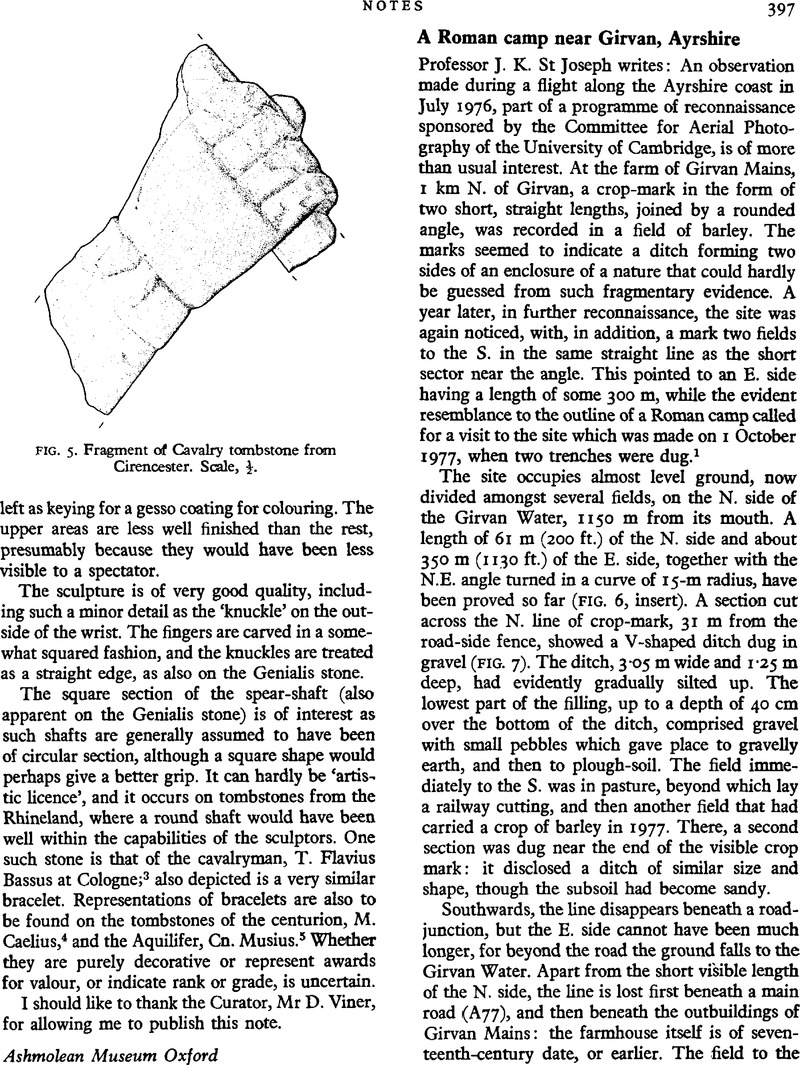Article contents
A Roman camp near Girvan, Ayrshire
Published online by Cambridge University Press: 09 November 2011
Abstract

- Type
- Notes
- Information
- Copyright
- Copyright © Professor J. K. St Joseph 1978. Exclusive Licence to Publish: The Society for the Promotion of Roman Studies
References
page 400 note 1. The sherd which forms the subject of this note is in the samian reserve collections of the Bristol City Museum, Reg. No. F 1800, and is published here by kind permission of David Dawson, Curator of Archaeology and History, City Museum, Bristol.
page 400 note 2. Simpson, G., JRS xlii (1952), 68–71Google Scholar, hereafter Simpson 1952. Her sherds Nos. 2, 4 and 5 are currently displayed in the Old Fulling Mill Museum, University of Durham, and I am grateful to Vicky Bonney, Curator, for making them available for study.
page 400 note 3. Webster, P. V., Britannia vi (1975), 163–70, hereafter Webster 1975.CrossRefGoogle Scholar
page 400 note 4. Bennett, J., Excavations at Nazareth House, Sea Mills, 1972, Bristol City Museum Monograph 3, 1978.Google Scholar
page 400 note 5. Simpson 1952, fig. 5, 1.
page 400 note 6. Simpson 1952, 71; and Webster 1975, 169.
page 400 note 7. Stanfield, J. A. and Simpson, G., Central Gaulish Potters (Durham, 1958), pl. 85, 1 and pl. 86, 14.Google Scholar
page 400 note 8. Stanfield and Simpson op. cit. (note 7), fig. 20, 3 and pl. 89, 16.
page 400 note 9. As note 5.
page 400 note 10. Stanfield and Simpson op. cit., 16; and Detsicas, A. P., The Anonymous Central Gaulish Potter known as X-3, and his Connections, Bruxelles-Berchem 1963, 18–19.Google Scholar
page 400 note 11. Young, C., Britannia ii (1971), 238–40.CrossRefGoogle Scholar
page 400 note 12. Bennett, op. cit. (note 4), Appendix 2, Moulded Coarse Wares of the Bristol Avon Valley.
page 400 note 13. Simpson 1952, 71.
page 400 note 1. Fulford, M. G., ‘Pottery and Britain's Foreign Trade in the Later Roman Period’ in Peacock, D. P. S. (ed.), Pottery and Early Commerce, Characterization and Trade in Roman and Later Ceramics, London, 1977.Google Scholar
page 400 note 2. Bird, J., ‘African Red Slip Ware in Roman Britain’ in Dore, J. and Greene, K. (eds.), Roman Pottery Studies in Britain and Beyond, Oxford, 1977Google Scholar; and D. P. S. Peacock, ‘Roman amphorae: Typology, fabric and origin’, in Coll. Ecole Franc. Rome, forthcoming.
page 400 note 3. We are grateful to Miss Barbara Green for allowing us to publish the Caistor mortarium, now in the Castle Museum, Norwich, in advance of the site report. For a summary of the original excavations see JRS xliii, 1953, 122.Google Scholar
page 400 note 4. Garbsch, J., Der Mooseberg bei Murnau, Munich, 1966, Taf. 45-51.Google Scholar
page 400 note 5. Thomas, E. B., ‘Die Romerzeitliche Villa von Tac-Fovenypuszta’, in Act Arch. Hung, vi, 1956, 120–123.Google Scholar
page 400 note 6. Bertacchi, L., ‘La Ceramica Invetriata di Carlino’, in Aquileia Nostra xlvii, 1976, 181–194.Google Scholar
page 400 note 7. P. Arthur and D. F. Williams, forthcoming.
page 400 note 1. The owner, who wishes to remain anonymous, found it within the area of the Roman town.
page 400 note 2. Dimensions, 8.·5 mm by 7·5 mm.
page 400 note 3. Pliny, , NH xxxv, 63.Google ScholarBrandt, E., Antike Gemmen in Deutschen Sammlungen. I Staatliche Münzsammlung, München Teil i Griechische Gemmen, Munich 1968, 78Google Scholar, No. 411, pl. 47. P. Zazoff, ibid.IV Hannover, Kestner-Museum, Wiesbaden 1975, 187, No. 933, pl. 122. Cf. also Jones, H. Stuart, The Sculptures of the Museo Capitolino, Oxford 1912, 128 f.Google Scholar, No. 54b, pl. 25 (for a fine Roman statue).
page 400 note 4. Toynbee, J. M. C., Art in Britain under the Romans (Oxford 1964), 324 f.Google Scholar, pl. LXXIV B. Cf. also Gehrig, V., Hildesheimer Silberfund in der Antikenabteilung Berlin, Berlin 1967, 19Google Scholar and col. pl. iii for a silver-gilt emblem from the Hildesheim treasure.
page 400 note 5. Henig, M., A Corpus of Roman Engraved Gemstones from British Sites, BAR 8, Oxford 1974, part ii, 43, No. 294, pl. x.Google Scholar
page 400 note 6. Ibid. 91 and pl. xliii, No. 686, for a first-century bronze ring from London.
page 400 note 1. RIB 108, and pl. III.
page 400 note 2. RIB 109, and pl. IV.
page 400 note 3. M. Grant, The Army of the Caesars (1974) pl. 19-H. Russell Robinson, The Armour of Imperial Rome (1975)) pl. 301.
page 400 note 4. M. Grant, op. cit., pl. 18.
page 400 note 5. M. Grant, op. cit., pl. 17.
page 401 note 1. The observation of the site on 27 July 1976 was by J. K. St Joseph (photos. CAN 22-24), the photography on 8 August 1977 was by D. R. Wilson (CEM 48-50): on both occasions the pilot was A. G. Douglass. The excavation on 1 October 1977 was undertaken by J. K. St Joseph and C D. St Joseph. Mr J. W. Young of Girvan Mains kindly gave permission for work on his land.
page 401 note 2. Pococke, R., Tours in Scotland, 1747, 1750, 1760. Ed. by Kemp, D. W., Scottish Hist. Soc., vol. i, 1887.Google Scholar
- 1
- Cited by


